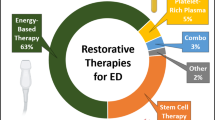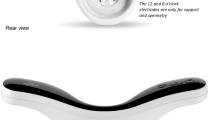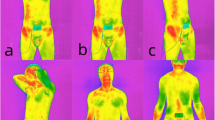Abstract
Erectile dysfunction (ED) affects approximately 150 million men worldwide. Functional electrical stimulation (FES) therapy has shown a high regenerative capacity for smooth muscle cells and, therefore, is being increasingly adopted. FES can be a beneficial treatment option when the cause of ED is related to degeneration of cavernous smooth muscle. To evaluate the impact of FES on erectile function in men with erectile dysfunction. Twenty-two patients with ED participated in this randomized clinical trial. Participants were randomly assigned to two groups: intervention (IG) or control (CG). IG participants underwent FES therapy (50 Hz/500 µs) for a total of 4 weeks, divided into two weekly sessions lasting 15 min each, with intensity lower than the motor threshold. CG participants were treated with placebo FES and followed the same routine as the IG. Erectile function was assessed by the validated International Index of Erectile Function (IIEF-5) and Erection Hardness Score (EHS), applied before and after treatment, and quality of life, by the WHOQOL questionnaire. Statistically significant differences in IIEF-5 and EHS were found between the IG and CG after treatment (p < 0.05), as well as a within-group difference in the IG when comparing the post-treatment periods (p < 0.0001) The WHOQOL revealed a significant difference between CG and IG after treatment (p < 0.05), as well as a within-group difference in the IG after treatment (p < 0.0001), except in the Environment domain, in which there was no difference between the pre- and post-treatment periods (50.9 ± 2.8 pre vs. 52.3 ± 3.1 post). This trial showed that FES therapy may improve erectile function and quality of life in men with ED.
This is a preview of subscription content, access via your institution
Access options
Subscribe to this journal
Receive 8 print issues and online access
$259.00 per year
only $32.38 per issue
Buy this article
- Purchase on Springer Link
- Instant access to full article PDF
Prices may be subject to local taxes which are calculated during checkout


Similar content being viewed by others
References
NIH Consensus Development Panel on Impotence. Impotence-NIH Consensus Conference. JAMA. 2013;270:83–90.
Pournaghash-Tehrani S, Etemadi S. ED and quality of life in CABG patients: an intervention study using PRECEDE-PROCEED educational program. Int J Impot Res. 2014;26:16–9.
McMahon CN, Smith CJ, Shabsigh R. Treating erectile dysfunction when PDE5 inhibitors fail. BMJ. 2006;332:589–92.
Hackett G. Patient preferences in treatment of erectile dysfunction: the continuing importance of patient education. Clin Cornerstone. 2005;1:57–65.
Al-Shaiji T, Brock G. Phosphodiesterase Type 5 inhibitors for the management of erectile dysfunction: preference and adherence to treatment. Curr Pharm Des. 2009;15:3486–95.
Hwancheol S, Kwanjin P, Soo-Woong K, Jae-Seung P. Reasons for discontinuation of sildenafil citrate after successful restoration of erectile function. Asian J Androl. 2004;6:117–20.
Claes H, Van Kampen M, Lysens R, Baert L. Pelvic floor exercise in the treatment of impotence. Eur J Phys Med Rehabil. 1995;5:42–6.
Derouet H, Nolden W, Jost W, Osterhage J, Eckert R, Ziegler M. Treatment of erectile dysfunction by an external ischiocavernous muscle stimulator. Eur Urol. 1998;34:355–9.
Andersson K-E Erectile physiological and pathophysiological pathways involved in erectile dysfunction. J Urol. 2003;170(2 Pt 2):S6-13-4.
Hurt KJ, Musicki B, Palese Ma, Crone JK, Becker RE, Moriarity JL, et al. Akt-dependent phosphorylation of endothelial nitric-oxide synthase mediates penile erection. Proc Natl Acad Sci USA. 2002;99:4061–6.
Gratzke C, Angulo J, Chitaley K, Dai Y-T, Kim NN, Paick J-S, et al. Anatomy, physiology, and pathophysiology of erectile dysfunction. J Sex Med. 2010;7(1 Pt 2):445–75.
Stief CG, Weller E, Noack T, Djamilian M, Meschi M, Truss M, et al. Functional electromyostimulation of the corpus cavernosum penis--preliminary results of a novel therapeutic option for erectile dysfunction. World J Urol. 1995;13:243–7.
Dean R, Lue TF. Physiology of penile erection and pathophysiology of erectile dysfunction. Urol Clin North Am. 2005;32:379–95.
Ignarro LJ, Bush PA, Buga GM, Wood KS, Fukuto JM, Rajfer J. Nitric oxide and cyclic GMP formation upon electrical field stimulation cause relaxation of corpus cavernosum smooth muscle. Biochem Biophys Res Commun. 1990;170:843–50.
Jiang J, He Y, Jiang R. Ultrastructural changes of penile cavernous tissue in multiple sclerotic rats. J Sex Med. 2009;6:2206–14.
Hatzimouratidis K, Amar E, Eardley I, Giuliano F, Hatzichristou D, Montorsi F, et al. Guidelines on male sexual dysfunction: erectile dysfunction and premature ejaculation. Eur Urol. 2010;57:804–14.
Paick J, Goldsmith P, Barta A, Nunes L, Padula C, Lue T. Relationship between venous incompetence and cavernous nerve injury: Ultrastructural alteration of cavernous smooth muscle in the neurotomized dog. Int J Impot Res. 1991;3:173–84.
Myung-Cheol G, Yun-Chul O, Tae-Woo K. The effect of treatment of erectile dysfunction with electrical stimulation. Kor J Androl. 2000;18:149–55.
Althof S. Quality of life and erectile dysfunction. Urology. 2002;59:803–10.
Araujo A, Durante R, Feldman H, Goldstein I, McKinlay J. The relationship between depressive symptoms and male erectile dysfunction: cross-sectional results from the Massachusetts Male Aging Study. Psychosom Med. 1998;60:458–65.
Lewis RW, Fugl-Meyer KS, Corona G, Hayes RD, Laumann EO, Moreira ED, et al. Definitions/epidemiology/risk factors for sexual dysfunction. J Sex Med. 2010;7(4 Pt 2):1598–607.
Author information
Authors and Affiliations
Corresponding author
Ethics declarations
Conflict of interest
The authors declare that they have no conflict of interest.
Rights and permissions
About this article
Cite this article
Carboni, C., Fornari, A., Bragante, K.C. et al. An initial study on the effect of functional electrical stimulation in erectile dysfunction: a randomized controlled trial. Int J Impot Res 30, 97–101 (2018). https://doi.org/10.1038/s41443-018-0024-8
Received:
Revised:
Accepted:
Published:
Issue Date:
DOI: https://doi.org/10.1038/s41443-018-0024-8
This article is cited by
-
Accurate diagnosis and effective treatment of abnormal meridians in erectile dysfunction patients based on infrared thermography: an electrophysiological technique study
International Journal of Impotence Research (2024)
-
Conservative Non-surgical Options for Erectile Dysfunction
Current Urology Reports (2023)



